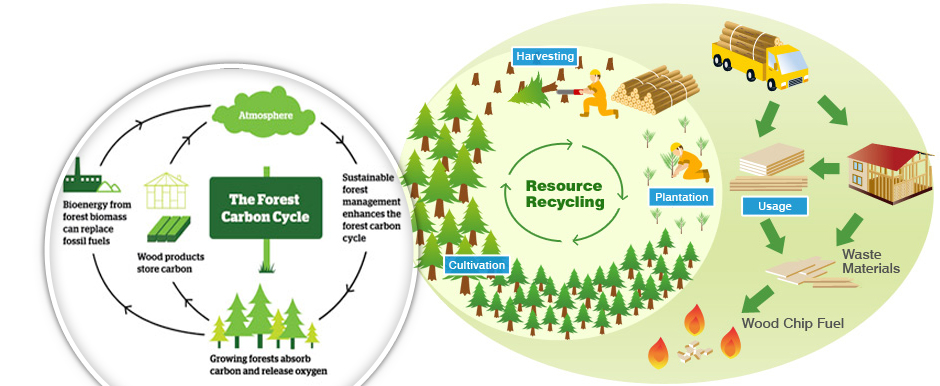It is commonly accepted that forests are the single most important factor in erosion control and water control, cultivating water resources, curbing global warming by absorbing CO2, preserving biodiversity, and so much more. For these functions to work effectively, proper forest management is crucial. Sustainable forest management is necessary to ensure that timber resources remain available over time.
The functions of forests that serve the public good can be enhanced by appropriate forestry management including weeding, pruning, and thinning. Forests absorb CO2 then retain it as carbon – or “carbon stock.”
Harvested trees that are milled and then provided to the world as a variety of applications, including housing and furniture in which cases the timber will be used for many decades. Even after trees are processed into products, the wood continues to retain CO2 as carbon. Thus, it can be said that using wooden products and building wood-construction homes are activities that “create forests in homes.”
Wood products can still be used effectively even after they have served their purpose. For example, in the case of wood-construction homes, the lumber can be re-used after demolition as wooden materials such as boards. Wood chips resulting from this process of re-use, and wood that has served its purpose as a wooden product, can still be used as wood fuel or as a compost complement (just to name a couple of examples). This is called cascade usage and is a way to use wood completely and totally. In this way, carbon is retained for a very long time – until for example the wood products are used as fuel, or are left to decay at which point the CO2 released is the CO2 that was absorbed during the tree’s growth process, so the CO2 in the atmosphere has not been increased during the life cycle of the tree. In the case when the wood ends up mixed up in a compost pile, the carbon is added directly to the soil which is another viable method of carbon fixing.
The longer the use cycle, the better. Especially given that in sustainable forestry, a major emphasis is put on planting new trees and on forest regeneration. For this reason the production of sustainable wood that is of premium quality is particularly important since it will yield wood-based products that will last longer. For example, traditional timber frame houses can last many centuries with adequate wood.
Just harvesting trees and using the timber means forestry resources will be depleted. In sustainable forestry we always plant and cultivate at least as many new trees as were harvested, (usually many more) to ensure sustainability of forest resources. From a carbon stock perspective, during the time wood products used in homes are retaining carbon, newly planted trees grow, absorb CO2, and retain carbon. By promoting operations that encourage greater use of sustainably and responsibly produced timber resources through the structural application and incorporation of wood. Sustainable forests and the carbon retained in the homes built with sustainable wood thus increase the carbon stock and contribute to counteracting the increasing carbon footprint of modern society.
However, sustainable forestry cannot be viewed from any single point of view (such as carbon stock for example). Natural ecosystems, wildlife habitats, biodiversity, soil fertility, genetic depletion, social impacts – both local and global, all play an active part in the sustainable forester’s mind. For this reason, sustainable forestry ought to be part of a lifestyle incorporated as an element within a greater whole-system living situation such as a farmstead (in our case). And this has little to do with money or business.




Leave A Comment